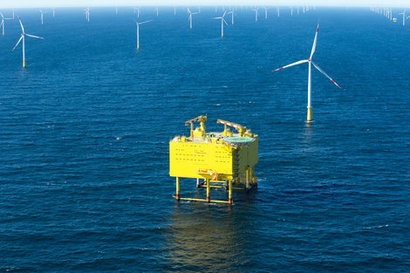
Siemens received the high-value order from the German-Dutch grid operator TenneT TSO. The company will be working with Spanish partner Dragados Offshore SA, which will be responsible for construction and installation of the offshore converter platform, and the French company Nexans, which will supply the DC cables. TenneT tendered the supply and laying of the cables separately, which means that synthesis services are not covered by the agreement.
Upon completion, DolWin6 will be able to transmit enough electricity to supply just under one million German homes with commercial commissioning expected in 2023. Siemens will supply the entire technology for efficient high-voltage direct-current transmission (HVDC) and wants to use DC direct-current CS compact switchgear for the first time. The new gas-insulated switchgear for 320 kilovolts (kV) requires as much as 95 percent less space compared to current air-insulated solutions. If they are deployed on the project, the size of the platform can be reduced by approximately 10 percent.
“DolWin6 marks a new milestone for the success of the energy transition” said Ralf Christian, CEO of Siemens' Energy Management Division. “We are very pleased with the new order from TenneT for at offshore grid connection in the German waters of the North Sea. This makes Siemens the technology partner in six out of ten DC projects. After BorWin3 and DolWin6 are commissioned, Approximately 4.7 gigawatts of electrical power will be converted and transmitted to shore using Siemens technology alone. This is enough to supply just under five million homes”.
Siemens expects the project to significantly lower the cost of grid connections for offshore wind farms and thus improve the grid parity of offshore wind energy in general. The switchgear is manufactured in Siemens Berlin factory while other components, such as HVDC transformers and converters are produced in Siemens Nuremberg plants. The offshore platform will be transported to the site after its manufacture by Dragados in Cadiz, Spain. Siemens will be responsible for complete construction of the onshore HVDC station in Emden, East Frisia, where the company already built the onshore converter for the BorWin3 direct-current connection earlier this year.
The DolWin6 grid connection is around 90 kilometres in length and will enable connection of multiple offshore wind turbines to the mainland. The 155 kV alternating current supplied by the turbines will be converted into 320 kV direct current on the platform and transported to Hilgenriedersiel on the mainland via a 45-kilometre subsea cable. This will pass underneath the island of Norderney by means of horizontal boreholes. It will then be transpoted by another 45-kilometre underground cable to Emden where another Siemens converter station will convert the direct current back into three-phase current and feed it into the national grid.
The HVDC Plus converter technology used by Siemens is a voltage-sourced converter of a modular multilevel converter design (VSC MMC), in contrast to the standard HVDC variant which can only be used in grids with sufficient short-circuit power.
Siemens is now implementing six out of a total ten DC North Sea grid connections for TenneT, the earlier projects being HelWin1 (576 MW) and HelWin2 (690 MW), off the coast of Heligoland, BorWin2 (800 MW) off the coast of Borkum and SylWin1 (864 MW) off the coast of Sylt.
Image: Offshore converter platform at the Sylwin Alpha project (Siemens)
For additional information:

